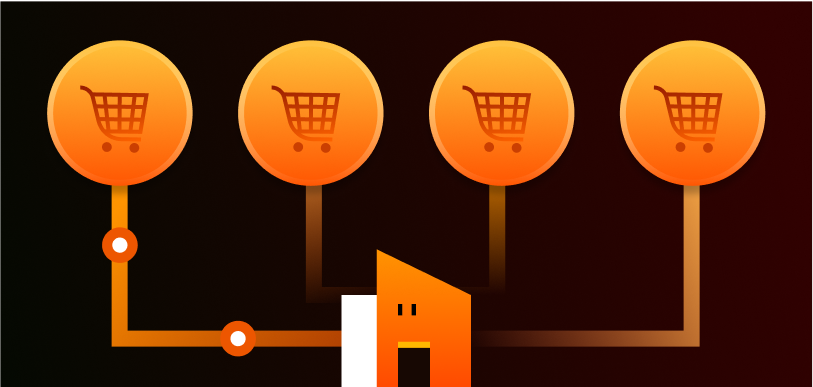
Data-Driven Supply Chain Resilience
Manufacturers, retailers, and producers of consumer-packaged goods (CPG) face a supply chain landscape governed by unreliability. As we noted in the first article of this series, supply chain disruption-as-a-rule has driven cost increases, upended delivery times, and endangered your ability to go to market. To thrive in this environment, it’s time to grow the maturity and resilience of your supply chain management with data-driven strategies.
Read on to find out what goes into developing supply chain resilience, and how you can get started.
Developing a digital roadmap
Transforming your supply chain management through data science is easier said than done. If you don’t want to lose your way in the sea of digital innovations, you need to design a long-term digital roadmap. This will help guide you to the data-driven supply chain resilience strategies that will deliver the highest ROI. Though this strategy may require a greater investment upfront than short-term tweaks of existing processes, it is the only way to guarantee long-term resilience.
That’s because your supply chain is already complex and becoming more so. Small adjustments around the edge will not be able to keep up with that growing complexity. And because your supply chain is the beating heart of your company, its health is tantamount to keeping your operations moving.
The business-critical aspect of supply chains makes a digital roadmap even more crucial. Without one, you run the risk of investing in the wrong technologies. Or worse, you remain stuck with outdated IT systems and processes — unable to quickly adapt to constant disruption. With a roadmap, you increase your agility and ability to innovate. That leads to reduced lead times, improved inventory management, and lower costs.
Evaluating supply chain maturity
Your ability to deploy advanced technologies is dependent on the current data maturity of your supply chain. There are four stages:

- Functional Focus: Processes related to supply chain functions are poorly defined and orchestrated, requiring ad hoc planning.
- Internal Integration: Supply chain processes and cross-functional metrics are transparent, defined, and planned. Resources are managed at the cross-functional level.
- External Integration: Supply chains are managed with strategic partnerships governed by mutual business objectives, common processes, and data sharing (including external data).
- Cross-Enterprise Integration: A collaborative digital supply chain ecosystem aligns the objectives and processes of all parties, enabling real-time planning, execution, and responses.
More mature supply chains have greater visibility over internal data and later over external data. Navigating the different stages requires taking a long-term view — making a roadmap essential. But growing your insight into potential problems gives you an enhanced ability to act before something goes wrong. And you can use that insight at any stage of the supply chain maturity.
Growing resilience through data integration
So, even if you find yourself to be at the lowest maturity, you can still begin to deploy dynamic analytics to pool data from internal and external operations and begin enabling data-driven decisions. That gives you real-time analysis of sales results, helping you dynamically align your supply strategy with demand changes, improve planning, and speed up responses.
Though you can begin deploying dynamic analytics at the functional focus level, its ROI will grow dramatically as the company progresses to higher levels and combines it with more advanced strategies:
 |
 |
|
|
Strategic Inventory Planning: By establishing supply chain buffers and new inventory targets at critical network nodes, you build resilience by introducing an inventory management system to automatically alert employees to add capacity or replenish stock. Your company will need internal integration across different nodes of the supply chain to make this strategy effective. |
Supply Network Redesigning: To boost supply chain resilience through flexibility, it’s crucial to be able to rely on redundancies. These can include in-house manufacturing of critical components and dual sourcing to prevent a supplier lock-in. You’ll need to identify alternative supply sources and make agile operational decisions with vendors and suppliers, making external integration key. |
|
 |
 |
|
|
Multitier Supply Chain Transparency: Visibility into multiple tiers of partners, not just into direct suppliers, is critical to monitoring KPIs. These include common ones such as timely deliveries or defects, and company-specific ones, such as credit ratings. Transparency also relies on strong partnerships and effective collaboration with real-time data sharing. Because multitier transparency requires you to manage your supplier network, you will need external integration. |
Simulations and Optimization: Virtual replicas or digital twins of your supply chain allow you to simulate different scenarios, assess performance, and identify network vulnerabilities. They also display your company’s assets, inventory items, warehouses, and logistics flow on a single dashboard, giving you access to your entire network. Because simulations’ data requirements are so high, you will need external or cross-enterprise integration. |
Your roadmap to supply chain resilience
Though reaching the highest stage of the supply chain data maturity spectrum takes work, you can get there with a digital roadmap. SoftServe can help you put that map together. With a specific focus on the retail, CPG, and manufacturing industries, SoftServe works closely with clients to understand their unique challenges and goals, and to develop solutions that meet their specific needs.
Supply chain resilience in the face of unpredictable conditions is essential for manufacturers, retailers, and CPG producers — and will be in the future as well.
So, if you are ready to build a roadmap to supply chain resilience and thrive in the world of disruption-as-a-rule, let’s talk.

